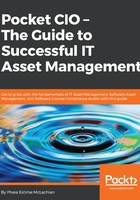
Leadership is not about luck
Understand that good leadership doesn't have to be a question of luck, and it certainly isn't magic. Leadership is a business skill like any other, the most important business skill of all. Work with mentor individuals, management teams, and larger groups to increase their leadership skills. Help them understand the dynamics of individual and organizational leadership. This is a proven delivery system for better thinking, smarter decisions, effective communication, motivated employees, and ultimately, better top-line and bottom-line business results.
Great leadership enables the following:
- Attracting and retaining top talent
- Motivating your workforce
- Shaping the personality and reputation of your organization
- Generating value from outsourced relationships
- Organizational change
- Employee awareness and communications
You must be thinking, what does leadership have to do with ITAM and building the case for ITAM?
Virtually, every enterprise of any size talks about ITAM strategy, but how many have successfully integrated it into their IT culture? The evidence suggests only about a third: in 2009, only 32% of IT projects started were completed successfully; another 44 % were considered partial failures, and 24% were considered complete failures.* A batting average of 0.320 might be terrific in Major League Baseball, but no business enterprise should accept such a paltry success rate.
There were many reasons cited for this dismal record of IT failure, such as lack of user input, lack of technical competence, changing requirements or specifications, lack of C-suite support, the economy, lack of resources, obsolescence, poor communication, the list goes on. In fact, all of these factors and many more would become moot, or nearly so, with a comprehensive ITAM strategy in place supported and led by strong leaders/champions of the ITAM program.
A good ITAM strategy starts with expert analysis of organizational needs, followed by C-suite buy in, which likes the operational efficiencies and cost savings over time. A well-designed ITAM strategy also makes the most of available resources, identifies technology and software needs based on business objectives and existing IT portfolios, and makes allowances for company growth and evolving technology requirements.
*Source: 2009 CHAOS Report on IT project success rates, published by The Standish Group, Boston.
The approach starts by asking key questions; here, you will learn what questions to ask, where to go to find the answers you need to help you build the case, and the answer to the hard question of how will ITAM benefit the business:
- What are the corporate goals? Check the company newsletter, town halls, presentations by the CEO, or the information for shareholders on the company website.
- What objective is your competition for budget, and does that objective have a stronger link to the corporate goals? If the link is stronger, you can choose to rework your priorities to a stronger case yourself, or you may choose to dovetail your objectives to the other. For instance, if a health-care system is faced with allocating funds between new imaging equipment and improvements for managing assets, propose reducing the need for redundant portable equipment through improvements in your asset-tracking project request.
- Have you sought external validation? Researching analyst and vendor white papers, and extracting relevant statistics and comments, takes the personal aspects out from your project request. Check out trends by reviewing headlines over a few weeks in technology and industry websites.
- Have you sought internal validation? Talk to peers and managers in other end departments and listen to their ideas. If you don't have internal numbers to back up your project request, perform a survey or a random inventory and report the findings.
- Have you increased the visibility of the good work you and your team have done already (savings, customer satisfaction, and so on) and highlighted the failures to be corrected in the requested budgeted project?
Look for strategic IT opportunities that will help you to build your case and strengthen a positive outcome to bringing ITAM to your organization. The following are a few examples to help you get started:
- Software audits: Audits by software companies and by compliance agencies are on the rise. Waiting to receive a letter leaves no options for reducing the number of licenses or buying licenses at non-crisis pricing. Can you prove the right to use? Understanding what information you need to keep and what choices you have during negotiations all deliver to the bottom line and to feeding accurate data for strategic planning.
- Acquisition/mergers: IT executives have an important role in determining the cost of integrating a new acquisition into the organization. The level of detail necessary to do the job right requires ITAM. Take advantage of software consolidation rather than be trapped with unexpected expenses. Regulatory compliance is scrutinized intensely during and after an acquisition. Manage this risk with the proper information.
- Technology to drive innovation: Technology certainly enables the business of the organization, but it can also make a difference in market leadership. When executives make a critical choice, it can provide the information they need to assess the advantages and disadvantages accurately. The "devil" in the details is an ITAM program that cannot deliver this critical information when needed.
- Profitability: To be part of the business, IT assets must deliver the expected value and facilitate achievement of business goals. Executives are accountable to shareholders and to industry regulators. Tax requirements, depreciation, and the value of corporate assets can all be verified or their accuracy can be improved by comparison to the tactical ITAM data.
Tactical goals drive the achievement of strategic goals. Group tactical actions and processes into objectives and begin to relate upwards. Here, you will learn some key objectives and their related actions and processes:
| Managing the life cycle |
|
| Managing costs |
|
Improving service |
|
| Supporting other initiatives |
|
| Managing risk |
|
| Providing decision support |
|